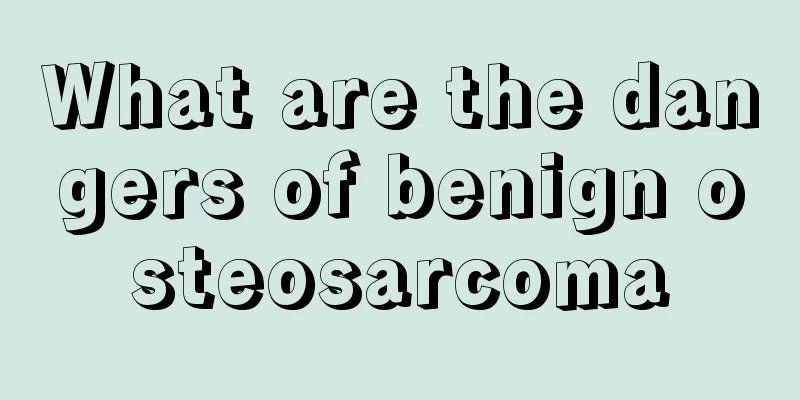The symptoms of lumbar disc herniation are like this

|
Lumbar disc herniation is a disease with a relatively high incidence rate nowadays. Its attack will not only make patients feel very uncomfortable, but also seriously affect people's normal life and work. Therefore, it is particularly important to understand the symptoms of lumbar disc herniation and to detect and treat it in a timely manner. Symptoms of lumbar disc herniation Simple lumbar disc herniation may not have any symptoms. Only when the lumbar disc herniation reaches a certain extent, or is combined with lumbar posterior joint dislocation, which stimulates or compresses the adjacent nerve roots or spinal cord, will the corresponding symptoms appear. It is generally manifested as low back pain after fatigue, accompanied by radiating pain and numbness in one or both lower limbs, protective spasms caused by pain, and the body leaning to one side when standing. The patient has difficulty walking and is reluctant to take a step. In severe cases, nerve paralysis and muscle paralysis may occur. Pain characteristics of lumbar disc herniation Lumbar disc herniation is the most common cause of low back pain, and the severity is as follows: worse during the day, worse at night, lighter in the morning, and heavier in the afternoon. It feels heavy after exertion, lighter after rest, heavier when standing, walking or sitting, and lighter when lying in bed. The pain is heavier when coughing, defecating and bending over, and lighter when staying still. The characteristics of the attack are: sudden, spasmodic and severe pain, which can be tolerated in mild cases and as severe as lightning. There is radiating pain in the lower limbs along the buttocks, and in the later stages, the leg pain is often more severe than the back pain. 【Clinical manifestations】 This disease has various clinical manifestations due to the location, size, duration of the nucleus pulposus herniation and individual differences. The main clinical manifestations are: 1. Lower back pain Almost all patients have this symptom in the affected part, which is mainly manifested in worsening of low back pain after fatigue or when taking the same posture for a long time, but the pain can be relieved after resting or lying in bed. If most of the nucleus pulposus protrudes, it suddenly compresses the nerve roots, causing the blood vessels at the roots to be compressed at the same time and causing ischemic pain. The pain will suddenly occur, the muscles of the lower back will spasm, and the pain will be spasmodic and severe. 2. Radiating pain in the lower limbs (sciatica) The pain mainly occurs along the buttocks, through the back of the thigh to the back of the calf or to the outer ankle and toes, starting as a dull pain that gradually worsens. A small number of patients may experience pain radiating southward and upward, first from the foot, calf, outer side, posterior and outer side of the thigh to the buttocks, mostly on one side, but may also be bilateral if it is a central protrusion or multiple protrusions. The protrusion is large and the condition is serious. Sciatica is also serious; if the pain is mild, the patient can bear it; if the pain is severe, it is like lightning and will occur at the slightest movement of the patient. When you hold your breath when coughing or sneezing, abdominal pressure increases and the pain worsens. Patients with herniated disc often experience more severe leg pain than back pain in the later stages. 3. Numbness and paresthesia in the lower limbs Numbness of the lower limbs is usually accompanied by radiating pain in the lower limbs. Clinically, there is a distinction between subjective numbness and objective numbness. In subjective numbness, patients feel numbness in their legs and the back of their feet, as if thousands of small insects are crawling on them, but acupuncture tests show that the skin on other parts of the body is exactly the same. In objective numbness, when the skin is pricked with a needle, the pain sensation is reduced and is different from the sensation on the skin in other parts of the body. 4. Difficulty walking Patients have difficulty walking and are unwilling to take a step. A few patients feel numbness, swelling, and unbearable pain in their legs after walking for a long time and need to sit down or squat to rest, experiencing neurological intermittent strabismus similar to spinal stenosis. 5. Muscle paralysis and atrophy When lumbar disc herniation severely compresses the nerve roots, nerve paralysis and muscle paralysis may occur, manifested as foot drop. Patients with severe symptoms and a long course of illness often have muscle atrophy, especially calf muscle atrophy, and from the appearance, the muscle volume decreases, causing lower limb muscle atrophy. 6. Cauda equina syndrome Common symptoms include numbness and tingling in the perineum, difficulty in defecation and urination, and sometimes sciatica that occurs alternately, sometimes on the left and sometimes on the right. The sciatica then disappears, leaving incomplete paralysis of both lower limbs. Female patients also suffer from pseudo-incontinence, and male patients suffer from impotence. 7. Limited functionality In addition to difficulty walking, patients often maintain a specific posture to reduce compression on the nerve roots, coupled with protective spasms caused by pain. When standing, the body leans to one side, the pelvis on the affected side rises, the hip and knee joints are slightly bent, the sole of the foot is on the ground, and the weight mainly falls on one side. He has difficulty squatting and cannot tie his shoelaces. He prefers lying on his side with his hips and knees semi-flexed. When getting up from a chair or bed, use both hands to support your waist and get up slowly. 8. Weakened dorsiflexion of the big toe and ankle joint It is caused by varying degrees of disorders in the nerve innervation of the hallux longus brevis extensor muscles and tibialis anterior muscles of the affected limb. |
<<: Endocervical polyps with squamous cell carcinoma should be treated like this
>>: Can diabetics eat jellyfish? 8 great tips for diabetic diet
Recommend
In which cases should uterine cancer examination be done? 4 cases must be screened for uterine cancer
Uterine cancer is a disease of the female reprodu...
What are the adverse reactions of vitamin overdose?
Vitamins are a type of trace element that is very...
Which department should I go to for facial pain
If a person experiences facial pain and external ...
My face suddenly turned red and hot
Allergy is a disease that everyone is familiar wi...
How to check for endometrial cancer
Endometrial cancer is a serious gynecological dis...
Brief analysis of the three main symptoms of rectal cancer
In real life, the symptoms of early colorectal ca...
What is the effect of raising your legs
When exercising, many people will raise their leg...
Can sweet potato flour replace cornstarch?
Sweet potato powder is actually the powder formed...
How to remove oil stains from clothes
It is very troublesome to have oil stains on clot...
Does the incision after lung cancer surgery need to be sutured?
Open incision after lung cancer surgery generally...
When is the best time to plant onions
I believe everyone must have eaten onions in thei...
Who can't eat chicory
People who pay more attention to health and welln...
How to choose sunglasses
When the weather is hot or the sun is shining bri...
I feel uncomfortable in my stomach after eating durian
Durian is known as the "Queen of Fruits"...
How long is the survival period for advanced kidney cancer
How long is the survival period of patients with ...









